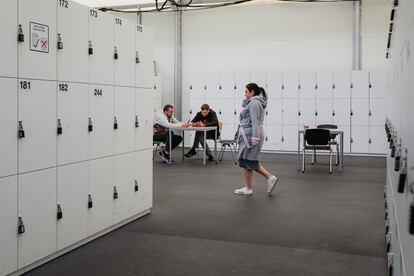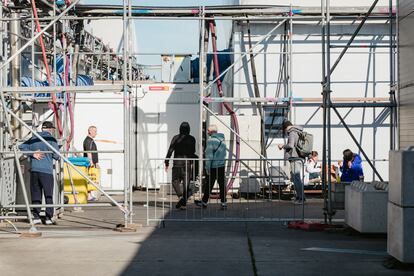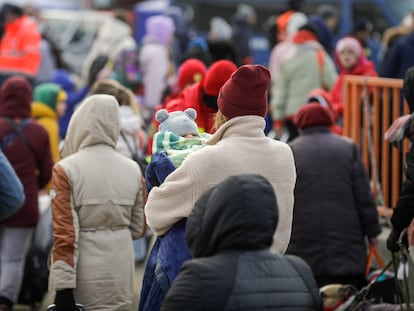The eternal wait at the EU’s largest refugee center in the former Berlin airport
Around 4,700 people are waiting an average of 285 days in the Tegel shelters for a place to stay. ‘I came here to work. I didn’t think I would be stuck here,’ says a Ukrainian


“I’ve been trying for months to get a flat so I can leave here with my family,” laments Viktor Olug, leaning on his cane in one of the 27 temporary sheds erected near the former Terminal C of Tegel Airport in northern Berlin. His eyes are filled with sadness. Showing the two scars on his neck, he says he has suffered five strokes, two in Berlin and three in Ukraine. “I need peace and quiet. It’s too noisy here,” he says. Olug, 69, came from Ukraine with his son, daughter-in-law, and three grandchildren. “It will be two years in December.”
Olug’s endless wait is not an isolated case. It is the most common criticism aired in this refugee reception center, which, with 4,677 people, according to data from the Berlin State Office for Refugee Affairs (LAF), is the most populated in the European Union. Many people repeat the rumor that someone got a flat after waiting only a month, while they remain trapped in this kind of black hole. However, a rumor is usually just that: a rumor. The reality is that the average wait is 285 days. The endless bureaucracy and lack of accommodation prevent applicants from leaving. Once inside, it is very difficult to get out.

“I was told I could work and live here, but when I arrived I couldn’t. I feel cheated,” says Lilia Kopylenko, a feisty 58-year-old from Dnipropetrovsk in central Ukraine, who cooks every day outside the facility at a nearby river after falling ill with gastroenteritis in the first few days. “I don’t want to be here. It’s very dirty sometimes and the food is awful,” she says. Kopylenko, who has two children in Ukraine, came to Berlin alone a year and seven months ago. “I came to work. I didn’t think I would be stuck here,” she says.
Henadii Schevchenko left Kharkiv with his brother, who is in a wheelchair, but they were separated at the Polish border due to a problem with their papers. His brother ended up in a center in southern Germany and he in Tegel. He has been here for 11 months and has been trying to meet his brother ever since so that he can help him. “They won’t let me go, nor will they let him come. It would be easier to find a flat for two, but that’s not possible. I’m stuck in an endless circle,” he says from his bed.
Despite its size, Tegel is hardly known outside Germany. According to the UNHCR, the Moria refugee camp on Lesbos once housed 20,000 people, but now there are just over 1,400 people there. “Meanwhile, the facilities in Samos (3,768) and Leros (2,109) are now larger, but do not have the 5,000 places Tegel has,” said a spokesman.
Tegel, built in 1948 in the former French sector to cope with the Soviet blockade of the city after World War II, closed in November 2020. In March 2022, the suitcases returned to one of its terminals, but this time in the hands of thousands of Ukrainians. “In November 2022, Berlin’s capacities were overwhelmed and tents were erected to accommodate them,” explains Sascha Langenbach, press officer for the LAF. “It is very, very hard to live here, but it is better here than under a bridge,” he adds, referring to facilities originally intended for refugees to spend just a few days.
A shuttle bus connects the nearest transport stops to the refugee center. Asylum seekers are greeted by security personnel as they enter through the gate provided in Terminal C. Once inside, they must pass a security check to detect objects such as knives and gas stoves or similar devices that could cause a fire, as happened last March when a tent was set alight. Then, if they are already registered, they only have to scan their QR code at the next checkpoint — a code that is also scanned upon exiting. Otherwise, they will have to sit in the waiting room for the authorities to take their personal and biometric data.
The old signs in the terminal are interspersed with information in many languages, and the check-in counters are now information desks. The feeling of temporariness and improvisation permeates everything. Nadiia, a 78-year-old from the Ukrainian city of Kharkiv, has come with her two grandchildren to register. She is one of the lucky ones. After giving her details, she will move in with them in their apartment in the south of Berlin.

Those who are not as fortunate as Nadiia are assigned to a specific bed. If they do not come to sleep two nights in a row, they lose their place. In Terminal C itself, there is space for 900 people. Outside, the huge white warehouses line the tarmac, as do the cables, scaffolding, and fences. The halls are accessed through a QR code-scanning checkpoint, which leads to a common area with a canteen, lockers, and a room with toiletries. A corridor at the end connects this part of the building with the bedrooms located to the right and left.
Each area, which can accommodate 350 people, has rows of rooms where an average of 10 people sleep in bunk beds behind a curtain, with their personal belongings piled on mattresses, with no privacy and almost no space. Some are for women only, others for men or families, but sometimes they are mixed.

A petite woman waits patiently in the corridor. Ludmila Sahovora’s gaze reveals the horrors of war. She has been here for almost two years. “My husband died in the war. I was hit by a missile while I was working and I have had medical problems ever since,” says the 67-year-old.
She is one of 3,639 refugees from Ukraine living in Tegel. There are also 1,038 from other countries, mainly Syria, Afghanistan, Turkey, Moldova, and Vietnam. There is room for almost 2,000 more people. In addition to the refugees, there are 455 NGO staff, 150 catering staff and 500 security personnel, divided into two 12-hour shifts. “All of this is very expensive. Tegel alone costs €35 million a month,” Langenbach says. This means more than €7,000 a month per refugee — a cost used as ammunition by the German far-right to attack the government.
The LAF is responsible for housing refugees, but has entrusted the management to the German Red Cross. The latter has also handed some tasks to aid organisations such as Malteser. Security is handled by Messe Berlin, a state-owned company specializing in congresses. In addition, there are rental costs for the venue and the tents, as well as cleaning, water, electricity, and heating.
The facilities include a clinic with two doctors and a paediatrician, as well as a leisure area where four children do crafts, a teenager plays the piano, and another plays with wooden blocks. Children aged under seven must be accompanied by their parents. Taking advantage of the sunny day, many prefer to ride their scooters along the former runways. In the background, in a hairdressing salon, a young Afghan man trims his beard, while Ibrahim — who was a hairdresser in Syria — cuts his friend Mohammed’s hair.

In the same hall is the study area, where several people are sitting with their laptops, such as Charles Finney, a Ukrainian born in Texas 59 years ago. During his work as a paramedic in Ukraine, he suffered frostbite in his foot and was taken to Berlin for surgery. Four of his toes were amputated. He tried to find a flat, but spent four months living illegally in a basement, so he returned to Tegel, where he has been for a year. In the meantime, he works on applications with artificial intelligence on his computer. “Life is a sinking ship, but you have to keep rowing,” he explains in perfect German, thanks to his studies in Vienna. “Tegel is a parallel world,” he says about what it is like to live there.
Next to him is Jenyd Toma, 21, who arrived four months ago fleeing the war. “I was in the army for two years and seven months. They let me go to accompany my mother to Turkey for medical treatment because she is very ill,” he says in English. “It is very difficult to leave the army. But if you give money, or with a special permit, you can leave the country and the army,” he explains. From Istanbul he fled to Berlin. “If I go back I have to go to the army again.”
“He’s like Balenciaga. He has a brand in Ukraine,” Finney says of the young man, who had a clothing store in his home country and dreams of opening one in Berlin.
It is already lunchtime. In the canteen in one of the sheds, Hamza serves food to the few people present. “It is chilli without meat,” he says. “This is ketchup. You can’t eat it,” complains Vasyl Rusnak, a teacher who arrived with his son from Chernivtsi a year and a half ago. “I don’t understand why I am still here. I do everything I am told,” he laments about a life that continues in this place, despite everything.

Sign up for our weekly newsletter to get more English-language news coverage from EL PAÍS USA Edition
Tu suscripción se está usando en otro dispositivo
¿Quieres añadir otro usuario a tu suscripción?
Si continúas leyendo en este dispositivo, no se podrá leer en el otro.
FlechaTu suscripción se está usando en otro dispositivo y solo puedes acceder a EL PAÍS desde un dispositivo a la vez.
Si quieres compartir tu cuenta, cambia tu suscripción a la modalidad Premium, así podrás añadir otro usuario. Cada uno accederá con su propia cuenta de email, lo que os permitirá personalizar vuestra experiencia en EL PAÍS.
¿Tienes una suscripción de empresa? Accede aquí para contratar más cuentas.
En el caso de no saber quién está usando tu cuenta, te recomendamos cambiar tu contraseña aquí.
Si decides continuar compartiendo tu cuenta, este mensaje se mostrará en tu dispositivo y en el de la otra persona que está usando tu cuenta de forma indefinida, afectando a tu experiencia de lectura. Puedes consultar aquí los términos y condiciones de la suscripción digital.
More information

Objective: Flee Lebanon by land, sea or air
Archived In
Últimas noticias
Aquilino Gonell, former Capitol sergeant: ‘If it hadn’t been for the police, the US would be a dictatorship’
A hybrid building: Soccer pitch, housing, and a shopping mall
Europe urges Trump to respect Greenland following annexation threats
Science seeks keys to human longevity in the genetic mixing of Brazilian supercentenarians
Most viewed
- Alain Aspect, Nobel laureate in physics: ‘Einstein was so smart that he would have had to recognize quantum entanglement’
- Mexico’s missing people crisis casts a shadow over World Cup venue
- Why oil has been at the center of Venezuela-US conflicts for decades
- Alvin Hellerstein, a 92-year-old judge appointed by Bill Clinton, to preside over Maduro’s trial in New York
- Cuba confirms death of 32 of its citizens in the US attack against Venezuela









































